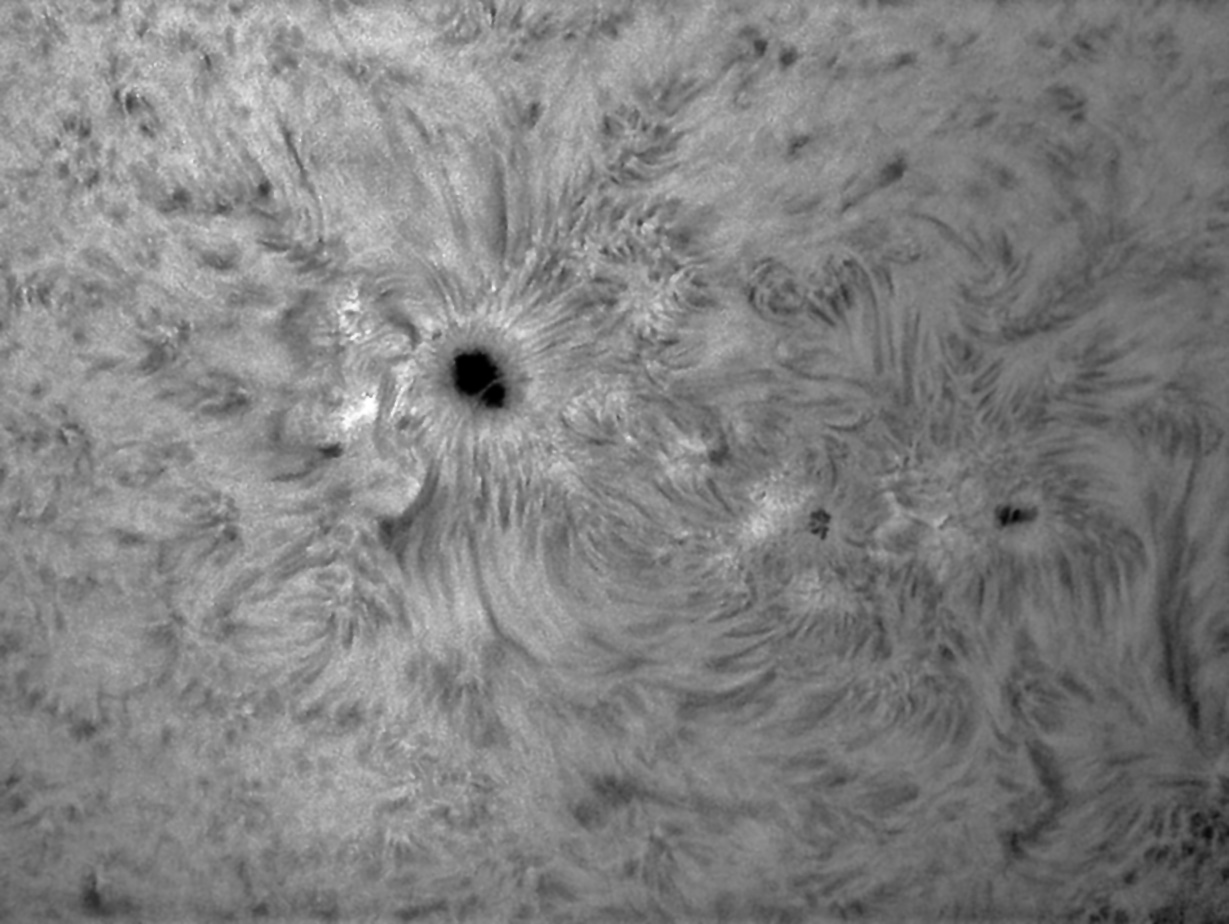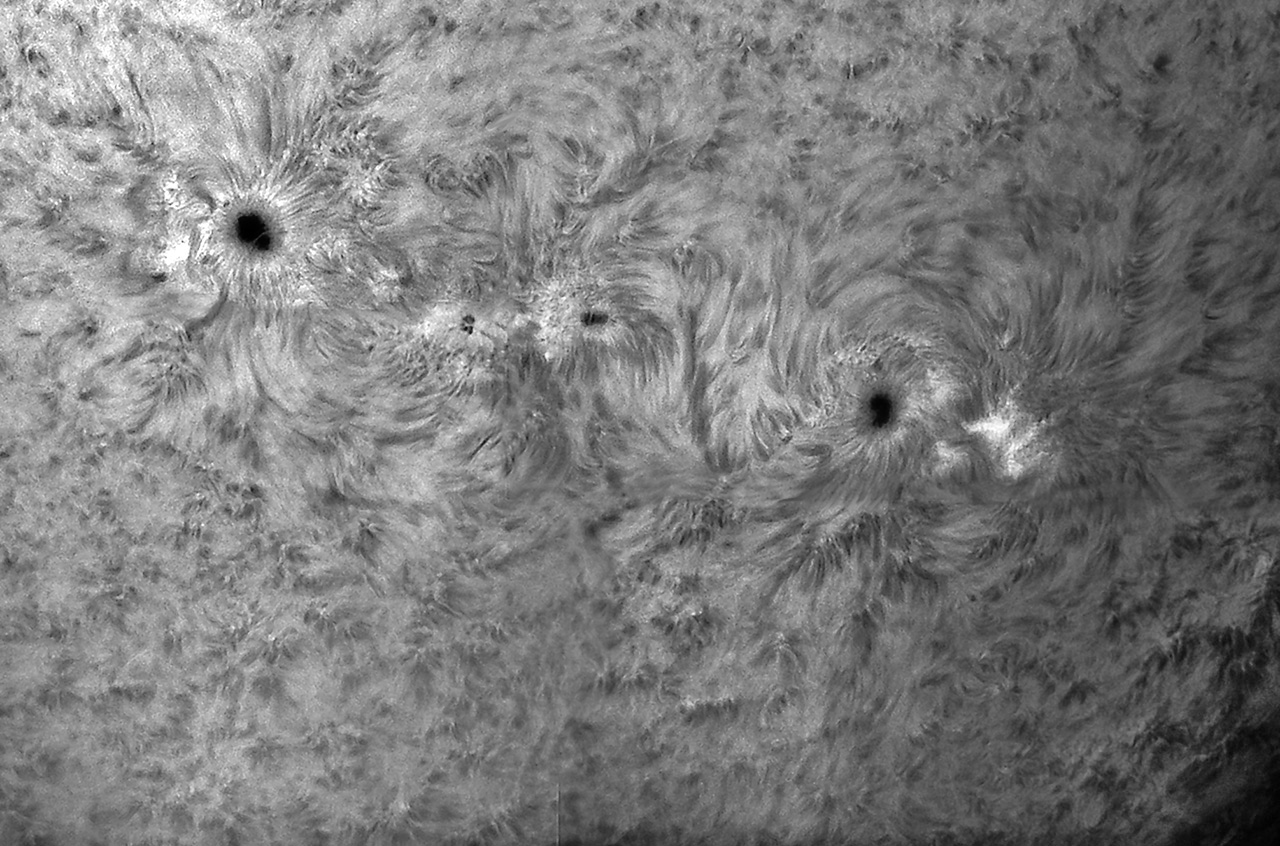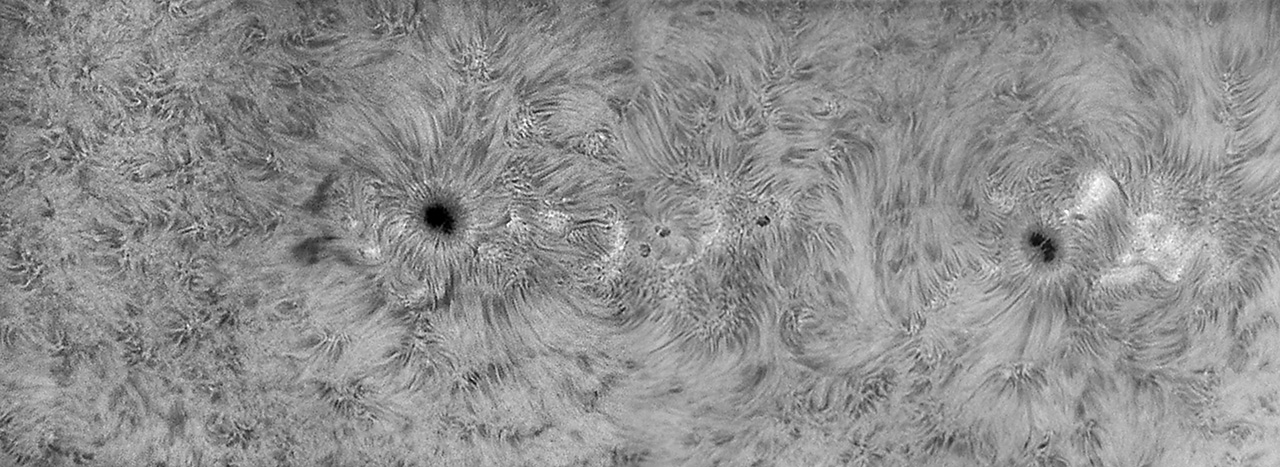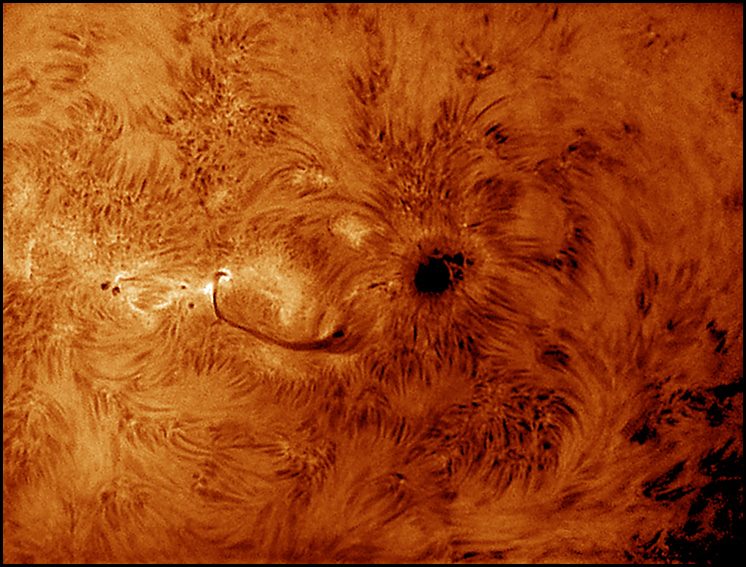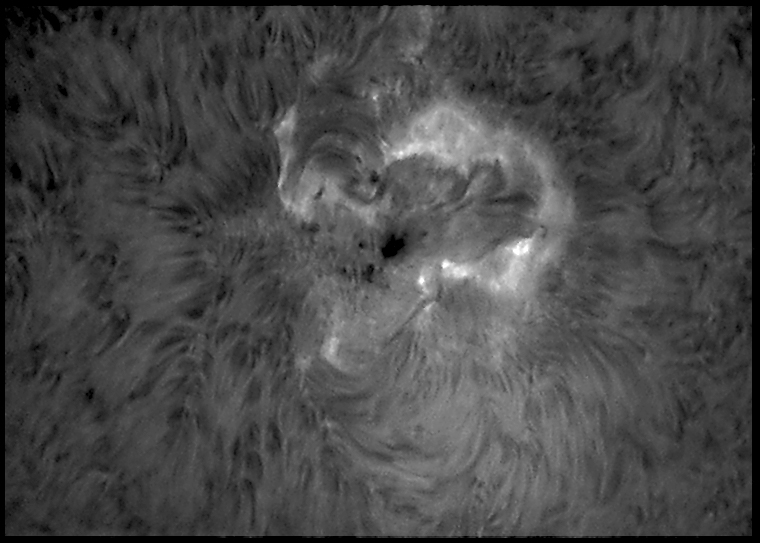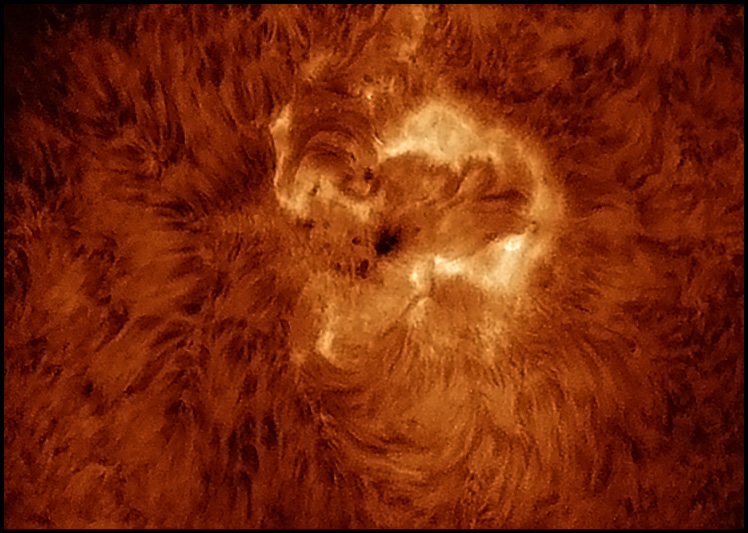|
For example, today I found a narrow bridge on the Sun that crossed the umbra of AR1569. As near as I can measure, it was 4,500 miles long and 400 miles wide. It would stretch from Charlotte to Rome (or from Chicago to Algiers) and was about as wide as Kansas:
Best 128 frames from 2,060.
I used part of the cloudless afternoon to stitch together a 4-pane mosaic showing both active regions and the complex plasma surrounding them at 0.33 arcseconds per pixel. Here it is as much-reduced scale:
The workflow to get seamless mosaics is not quite nailed. "Dynamic masks" help, but a real flat (or, ideally, an evenly illuminated field) would be better.
9/15/2012. Up and at it early to leave time for Riverfest and volunteering with the OFA crew in Morganton this afternoon. I took only two clips: one centered on AR1571, the other on AR1569. The air was visibly calmer, the details on the screen much cleaner.
Right click and "view image" to see this image at half resolution (1280 pixels wide)
For a little extra added excitement, I strained something in the Robofocus outfit when I slewed to this part of the sky. Then I finished the job while checking out the cable. I've inquired about a new 10-pin stepper cable and will look into a DB-9 female IPC crimp adapter. In the meantime, manual focusing for me. [Fixed: easily crimped on a new adapter; uhm, actually, the trouble may have been with inappropriate stepsize and pause parameters which I had adjusted just prior to the slew that put things under tension.] I got frustrated looking through a keyhole at the PGR Chameleon chip when using the outfit locally. The tiny Asus Aspire One computer has performed beautifully, but the tiny screen is a problem when not networked onto my office desktop. A larger screen would let me focus and compose effectively at the computer with no, or little, downside when used remotely. So I shopped up a 1600x900 notebook on eBay and found a refurbished Toshiba with the big screen and more RAM (longer clips without streaming). I hope, too, that the more capable processor will let me stream video faster. It will be a joy to be able to frame and focus. In a few hours, Toshiba sold 50 of the 52 they offered; I called dibs for #51. As a bonus, it will work as well in the cul de sac as in the backyard, the better to keep imaging after the Sun moves south behind the pines. Some cloudy day, I'll have a lot of software to move or reinstall.
9/23/2012. It's been a frustrating few days trying to get the Toshiba and the Chameleon to work together. Twenty-two programs and packages installed nicely enough. But... the USB ports on the Toshiba don't provide enough juice, especially when running on its internal battery. And I suspect both ports share a common interface internally, so the Chameleon runs out of bandwidth. I get inconsistent results from trials in the backyard, though things seem to work very well in the office. The meaningful difference seems to be that I am using the Chameleon by itself in trials in here while out at the telescope, other devices vie for power and bandwidth (two serial ports, and a GPUSB guider port all on a powered hub). Running the Chameleon on the same powered bus works some of the time. Running everything off a deep cycle battery helps some of the time. But I am only getting about 7 fps, and still I get dropouts where the frame is split into 2 or 4 zones for a few frames (which, of course, always get selected by Avistack). The literature suggests that the Chameleon should have its own port and a powered one at that; so perhaps I have simply been lucky on the Aspire One all this time. Add in some excitement from using Flycapture2 under Windows 7 rather than Flycapture under Windows XP and some puzzlement that files are now twice as large and that for some reason AVIStack2 does not like them without a pass through VirtualDub first. Still, the extra real estate is invaluable when operating out beside the telescope and the lovely throughput of Radmin 3.4 over ethernet (rather than Remote PC) make it worth making the new kid happy. At worst, I'll run two computers; the Aspire One to handle everything except image acquisition, the Toshiba for that. It's really only an issue when trying to operate remotely. The 152mm focuses nicely by hand; and if I am out by the telescope, I can use a handpad to move around. One battery in the trunk of the Honda should be plenty for the mount, the computer, and an inverter for a powered hub (since I am too cheap to buy another DC-powered hub, at least until I am sure about how to make it all work).
9/24/2012. A hub and fresh A-MiniB cable are enroute. In the meantime, I tried again with the Toshiba (plugged into a deep cycle battery) driving only the Chameleon (plugged into each USB port in turn). No joy there, so I retired the Toshiba until the hub arrives and took data using the Aspire One:
About the time I got the stream started, Raymond summoned me to the cul de sac. I feared he had treed a golf cart. During the walk there and back (about a quarter mile, round trip), the 'scope gathered 4,800 frames. That's the best 250 of them up above. So here I am working toward Cai-Uso Wohler's monochrome tonality when I suddenly become aware of the killer faux-color palette Australian Ralph Smith is using. I think the key that makes his colors so much nicer than mine (or part of it) lies in the use of levels rather than curves to produce the color rendition. At least that's what my first attempt to compliment him by emulation suggests:
I think it needs more and purer red in the "shadows," but the yellow highlights are a good start, and I think a significant improvement over most of my previous colorized H-a imagery. Shifting the hue and saturation of the red channel produces better versions of the image displayed above. I'll keep looking for a one-step conversion. Amazon and UPS tell me to expect a new data/power cable and a powered hub for the Chameleon sometime tomorrow (Tuesday). Weather looks good at least through Wednesday. So I need to clean up the G11 for solar duty real soon. The rest of the pieces are ready for a try.
9/25/2012. With the new toys came clouds, but that didn't stop me from trying them out in the backyard beside the telescope. The Sun even obliged from time to time. Things are not perfect, but they are better. Quality of power matters. With the USB hub plugged into an AC line and the computer running from the deep cycle battery, I got more successful runs than un, and some of them were 2,000 frames long. The camera ran for an hour at a time, maybe more. And to get rid of the broken up image (where the same shot is cut up into 2 or 4 pieces and displayed out of place), just reselect the camera. Thing is, that kind of image breakup can occur for one frame at a time, and AVIStack2 invariably choses the broken up image as its model (of course: it's the most complex, with sharp edges, so is the most detailed JPEG frame in the clip). The USB running on the inverter did not work as well. And the computer running on its own battery did not work as well either. So good power matters, but good power is exactly what I don't expect to have in the cul de sac. Keep at it, count on using the Aspire for a while, keyhole view or no. I didn't throw the new USB cable into the mix. Next time. [9/26: no harm, but no help.] Here's a smokey view of a new sunspot, one just rotating into view, through hazy afternoon skies (a departing high pressure cell gave us a preview of autumn weather — it was lovely while it lasted):
Best 100 of 1000 frames
10/1/2012. Been a few days, but I got nothin' much to show. End of month deadlines, volunteering at the campaign, clouds, south-bound Sun -- excuses I have, images I do not. The USB frustrations with the Toshiba continue. Even with the power issue addressed by a powered hub, it just can't suck the data off the camera through the USB straw fast enough. Why should a Toshiba Satellite w/E300 CPU and 4GB of RAM for buffering be worse at this than the Aspire One (Atom 270 with 1GB of RAM)? Back to the little guy at least until I get this sorted. Getting the G11 out of storage and cleaned up for portable duty comes first. I disassembled the head today and cleaned and relubed whatever seemed to need cleaning and relubing. I didn't open up the gears since they were well adjusted when I put it away. Until I see a good reason to mess with the RA worm, I'm going to assume it's fine. 10/2/2012. I fought (and mostly won) several small battles getting the 152mm solar scope onto the G11 mount. I replaced the counterweight lock bolts with stainless steel eyebolts (the plastic knobs long ago broke off, today one of the taper pins did the same; enough). The Linhof adapter that mates the Losmandy MA segment to the Linhof tripod refused to be inserted; I sanded and lubed it. The socket head bolts that hold the 152 to the homemade D-plate blocked the dovetail; I must have thought I could tip it into the Losmandy saddle as I can into the A-P saddle. I removed one offending bolt; the others are OK. The homemade D-plate that works fine on the A-P saddle was just a little too narrow to be gripped by the G11 saddle; I modified the clamping block on the G11 to get another 2-3mm of clamping range (carbide plate, table saw as milling machine...). The pins on the RA motor are all askew. How? What? When? Who cares because it works (but I dug out a spare motor just in case). I removed the RoboFocus bracketry from the Lunt's clamshell. While operating away from the A-P, Robofocus anything is dead weight, at least for now. The 152 balances well and seems solid; it looks good, neither ungainly nor undermounted. Before going to the trouble to take it to the cul de sac, I want to more thoroughly debug it down here (lesson learned from trying to do a show and tell for Dr. Higgs' grandson Sheldon when a small omission on my part stopped the show dead). I should be ready for sky trials by the time the weather cooperates.
10/12/2012. I'm more or less routinely hauling the outfit up to the cul de sac and operating it out of the trunk of the Honda using the Aspire One for camera control. It works smoothly enough. Polar alignment is hit or miss, but the first few sessions have been useful. I replaced that iffy RA motor during the first session in the cul de sac; I'll wire in a new RJ11 connector and move that motor to my box of spare parts whence cometh the one that works well. I've yet to get up there to take advantage of cooler, calmer morning air. This photo was picked off the western treetops during a brief clearing in afternoon clouds:
These images are noisier than I'd expect from the number of frames used (500) and they are not as sharp as I'd expect from inspecting the best frames. Poor seeing? Too-aggressive processing? Little bit of both? Lord knows I almost always push the data too hard. Does the excess drift caused by mediocre polar alignment contribute to the finished images' problems (it shouldn't, should it)? [SEE BELOW for the likely explanation of the image defects.] Keep at it. And maybe reduce the image scale when conditions are marginal (these were acquired at 0.33"/pixel). Get up into the cul de sac some clear morning (remember those?). Housekeeping: when we came home from TN on Tuesday, my 24-inch Samsung 2nd monitor was dead. I ordered a refurbished Dell 2209WA Ultrasharp to replace it. It arrived on Saturday from Dell's online storefront via free shipping. A Datacolor Spyder3 calibrated it without fuss; it looks great! The too-bright, too-garish, gamers' screen that looked good from precisely one p.o.v. will not be missed.
10/17/2012. Yesterday I discovered that the 75mm ERF had cracked. It seperated along a straight line through its diameter. The two halves were almost coplaner; the degree to which they were misaligned almost certainly accounts for the recently degraded performance of the telescope. Various observers on Solarchat are skeptical that heat caused this failure; they (and I) suspect that a mechanical shock during transportation or setup is the more likely cause. I have "dry fitted" the two pieces together atop a polished glass substrate (a 72mm nearly clear photographic filter by another name) and the reflection is literally flawless. Because the damaged filter still yields useful images, I believe that I can repair the damage well enough that the compromised ERF will not be the limiting factor. By and by, I will probably replace the filter, but for now I have ordered some optical cement to make this open-faced optical sandwich permanent. This seems like a good time to change the astronomical sheets (i.e., to put the Ritchey back on the Mach1 and get ready to climb back into the deep winter sky).
:: top ::
|
© 2012, David Cortner
